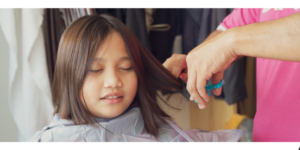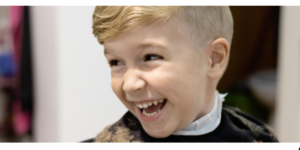Navigating haircuts for autistic children presents unique challenges and opportunities.
For many, the sensory experiences tied to haircuts can be overwhelming. The tactile sensation of scissors, the sound of clippers, or even the unfamiliar environment of a salon may trigger discomfort or anxiety.
Each child’s response to these stimuli is different, but understanding these reactions can help parents and caregivers transform a daunting task into a manageable, even positive, experience. Adopting specific strategies tailored to sensory needs can make haircuts less stressful for everyone involved.
The journey involves preparation, patience, and creativity to ensure the process is as smooth and reassuring as possible.
Grasping Sensory Sensitivities
Sensory sensitivities play a crucial role in shaping the haircut experience for many autistic children.
Unlike neurotypical individuals, autistic children may process sensory inputs in a heightened or atypical manner, making certain aspects of haircuts particularly challenging.
For instance, the tactile sensation of scissors against the scalp can feel unusually intense, while the buzzing sound of clippers might be perceived as unbearably loud. Even the smell of hair products can trigger discomfort or agitation.

These heightened sensitivities can result in significant anxiety or distress, making the haircut process daunting for both the child and their caregivers.
Understanding these unique sensory processing differences is essential in preparing for a more successful haircut experience. Observing and noting specific triggers can provide valuable insights into what might cause discomfort or anxiety for your child.
For example, some children might be more sensitive to touch, while others might find auditory stimuli more challenging.
Recognizing these individual differences allows you to tailor the haircut experience to better accommodate your child’s needs.
Incorporating sensory-friendly practices can help mitigate these challenges. For instance, using unscented hair products, opting for quiet, manual scissors over electric clippers, or allowing the child to hold and explore the tools beforehand can make the experience less intimidating.
By being attuned to these sensitivities, we can better support autistic children through each haircut, making the process more manageable and less stressful.
Getting Ready for the Haircut
- Visit the hair salon in advance to ensure your child becomes familiar with the place
- Practice cutting his/hair at home so that he/she knows what to expect
- Reward him/her with tokens of appreciation for bravery the day of the haircut
Preparation plays a pivotal role in ensuring a successful haircut for an autistic child. Begin by selecting a time when your child is most likely to be relaxed and in a good mood. This could be after they’ve had a restful nap or enjoyed a favorite activity.
Communicating what will happen during the haircut is crucial. Utilize visual schedules, social stories, or even role-playing to help your child understand the sequence of events and what to expect. These tools can help demystify the process and reduce anxiety.
It’s beneficial to involve your child in the preparation. Let them choose a favorite outfit to wear or a toy to bring along.
Familiar objects can provide comfort in a potentially stressful situation. Additionally, introduce them to the haircutting tools beforehand. Allowing your child to touch and see the tools up close can lessen the fear of the unknown.
Consider practicing at home by gently combing or pretending to cut their hair, reinforcing that the experience can be safe and even enjoyable.
If possible, visit the salon in advance without the pressure of a haircut. This can help your child become familiar with the new environment and the people they’ll meet. By thoughtfully preparing for the haircut, you can create a foundation for a more positive experience.
Picking the Ideal Hair Salon
Choosing the right hair salon can significantly impact the haircut experience for autistic children. It’s essential to find a salon known for being autism-friendly, where staff members are trained to accommodate sensory needs and demonstrate patience.

The environment plays a critical role; look for a quiet, well-lit space that minimizes sensory overload. When selecting a stylist, prioritize those who are open to listening and adapting to your child’s unique needs. A stylist who can personalize the experience and engage positively with your child can make a world of difference.
Consider salons that offer private rooms or off-peak appointments to create a more controlled, less overwhelming setting. Your child’s comfort and sense of security should guide your choice.
Establishing a Relaxing Atmosphere
Creating a calming environment during the haircut can greatly alleviate your child’s anxiety. Simple adjustments can transform the experience.
Start by controlling the sensory input: reduce background noise by turning off unnecessary devices and consider using noise-canceling headphones if your child is sensitive to sound. Soft, ambient lighting can replace harsh, bright lights, creating a more soothing atmosphere.
Music can be a powerful tool for relaxation. Playing your child’s favorite tunes or calming instrumental music can make the environment more familiar and less intimidating.
The presence of comfort items, such as a favorite stuffed animal, a blanket, or even a piece of clothing that your child finds soothing, can offer additional reassurance.
The use of scents can also play a role. Opt for natural, mild scents if your child is comfortable with them, avoiding any strong or artificial fragrances that might cause discomfort. You can also create a more familiar environment by allowing your child to watch a favorite show or engage in a preferred activity during the haircut.
Establishing a predictable routine can further reduce stress. Consistency in the setting, the stylist, and the process can help build familiarity and trust over time. Inform the stylist about your child’s preferences and triggers to ensure they can adapt their approach accordingly. These thoughtful adjustments can collectively contribute to a more serene and manageable haircut experience for your child.
Haircut Strategies Step-by-Step
Breaking down the haircut process into manageable steps can make a significant difference. Begin by introducing your child to the tools used during the haircut.
Allow them to touch and explore items like scissors, combs, and clippers in a non-threatening context. Demonstrating how these tools work on a doll or even on yourself can also demystify the process.
Next, explain each step of the haircut in simple, clear language as you proceed. For instance, let your child know that you’ll start by combing their hair, then move on to trimming the ends. Visual aids or social stories can be helpful here, providing a visual cue for each step.
Incorporating regular breaks can help manage sensory overload.
Pay attention to signs of distress or agitation, and allow your child to take a break when needed. This pause can be as simple as stepping away from the chair for a few minutes or engaging in a calming activity.
Positive reinforcement is key. Offer praise and small rewards for cooperation and patience. This could be a favorite snack, a sticker, or extra playtime. Over time, these positive associations can make the haircut experience more bearable, and even something your child might look forward to.
Post-Haircut Care and Encouragement
After the haircut, it’s essential to acknowledge your child’s effort and bravery. Celebrate their achievement, no matter how small, to reinforce positive experiences associated with haircuts. Acknowledging their effort can significantly boost their confidence and willingness to participate in future haircuts.
Consider planning a special treat or activity that your child enjoys. Whether it’s a visit to the park, extra screen time, or a favorite snack, these rewards can help create a positive association with the haircut experience.
Small tokens of appreciation, such as stickers or certificates of bravery, can also serve as motivational tools.
Reflecting on the experience together can provide valuable insights. Discuss what aspects your child found enjoyable and what they didn’t. Use this feedback to adapt and refine your approach for the next haircut, making it even more tailored to their preferences and needs.
If your child faced particular challenges during the haircut, think about strategies to address these in the future. For example, if they are uncomfortable with certain sounds, consider noise-canceling headphones next time.
Continuous adaptation and responsiveness to your child’s needs can make each successive haircut less stressful.
Maintaining open communication and showing appreciation can turn what might be a challenging experience into a confidence-building and positive routine for your child.

Closing Thoughts
Navigating the haircut experience for autistic children requires a blend of empathy, patience, and informed strategies. By understanding and addressing sensory sensitivities, parents can transform a potentially distressing activity into one that is manageable and even positive.
The key lies in preparation and a thoughtful approach to each child’s unique needs. Using familiar objects and establishing routines can help create a sense of security and predictability. Celebrating small achievements and providing positive reinforcement can build confidence and reduce anxiety over time.
Each successful haircut is a testament to your dedication and adaptability, setting the stage for a smoother experience in the future.

